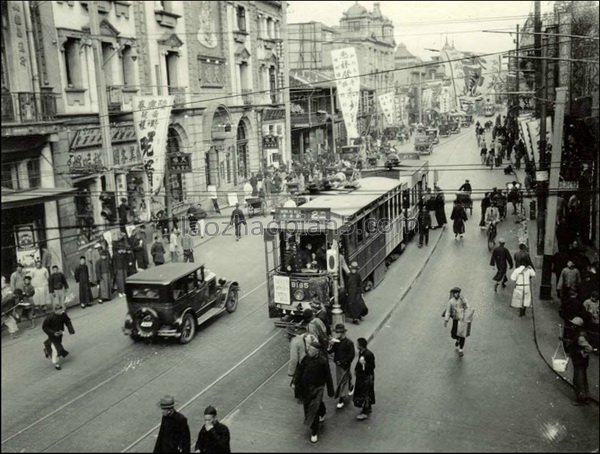Period:Ming dynasty Production date:1500-1600 (circa)
Materials:earthenware
Technique:glazed, moulded,
Subjects:servant/domestic worker
Dimensions:Height: 12.30 centimetres Width: 3.50 centimetres Depth: 3.20 centimetres
Description:
Two green-glazed earthenware funerary models of male servants. Apparently made from the same mould, these two male figures are distinguished from each other by minor variations in their glazing. Both stand in obeisance, ready to serve, on two-tier pedestal bases. They hold their hands together, close to the front of their chests and largely covered beneath their sleeves. They wear flat-topped pill-box-style hats and their hair hangs long and loose beneath. Both are dressed in round-necked short outer robes, tied at the waist, over longer robes, trousers and boots. Their outer robes are covered with a runny emerald-green glaze with incised details. Traces of slip, and black paint for eyebrows, hair and eyes, remain on the faces while a residue of red lacquer and gold is present on the hats and hands. Inside the figures are hollow.
IMG
![图片[1]-figure BM-1935-0418.4-5-China Archive](https://chinaarchive.net/Ming dynasty/43/mid_00273553_001.jpg)
Comments:Harrison-Hall 2001:Quantity, quality and composition of tomb furnishings vary greatly between burials, partly as a reflection of sumptuary laws which governed the status of tomb occupants. Many excavated burials of the scholar-official class have revealed upwards of seventy assorted tomb models. These are generally arranged outside the coffin, grouped as if engaged in the activities of daily life or positioned as if processing around a sedan chair. However, other burials of men of rank in the late Ming period have been found to have no clay or stone figures. In England, as a result of changes in religious belief, the practice of interring a corpse with grave goods came to an end in the eighth century AD. In China, by contrast, tomb models have been found dating almost one thousand years later than this: Qing burials include, for example, that of Wu Liuqi, who died in 1650 and was buried in Guangdong (Yang Hao 1982); and Li Yutang, who died in 1689 and is buried in Foushan, Shanxi.By far the greatest number of models in burials of all periods are probably replica people. This is intriguing, as it suggests that the dead needed company, attendants and other people even more than possessions.
Materials:earthenware
Technique:glazed, moulded,
Subjects:servant/domestic worker
Dimensions:Height: 12.30 centimetres Width: 3.50 centimetres Depth: 3.20 centimetres
Description:
Two green-glazed earthenware funerary models of male servants. Apparently made from the same mould, these two male figures are distinguished from each other by minor variations in their glazing. Both stand in obeisance, ready to serve, on two-tier pedestal bases. They hold their hands together, close to the front of their chests and largely covered beneath their sleeves. They wear flat-topped pill-box-style hats and their hair hangs long and loose beneath. Both are dressed in round-necked short outer robes, tied at the waist, over longer robes, trousers and boots. Their outer robes are covered with a runny emerald-green glaze with incised details. Traces of slip, and black paint for eyebrows, hair and eyes, remain on the faces while a residue of red lacquer and gold is present on the hats and hands. Inside the figures are hollow.
IMG
![图片[1]-figure BM-1935-0418.4-5-China Archive](https://chinaarchive.net/Ming dynasty/43/mid_00273553_001.jpg)
Comments:Harrison-Hall 2001:Quantity, quality and composition of tomb furnishings vary greatly between burials, partly as a reflection of sumptuary laws which governed the status of tomb occupants. Many excavated burials of the scholar-official class have revealed upwards of seventy assorted tomb models. These are generally arranged outside the coffin, grouped as if engaged in the activities of daily life or positioned as if processing around a sedan chair. However, other burials of men of rank in the late Ming period have been found to have no clay or stone figures. In England, as a result of changes in religious belief, the practice of interring a corpse with grave goods came to an end in the eighth century AD. In China, by contrast, tomb models have been found dating almost one thousand years later than this: Qing burials include, for example, that of Wu Liuqi, who died in 1650 and was buried in Guangdong (Yang Hao 1982); and Li Yutang, who died in 1689 and is buried in Foushan, Shanxi.By far the greatest number of models in burials of all periods are probably replica people. This is intriguing, as it suggests that the dead needed company, attendants and other people even more than possessions.
© Copyright
The copyright of the article belongs to the author, please keep the original link for reprinting.
THE END




![[Qing Dynasty] British female painter—Elizabeth Keith, using woodblock prints to record China from the late Qing Dynasty to the early Republic of China—1915-China Archive](https://chinaarchive.net/wp-content/uploads/2022/11/image-191x300.png)
